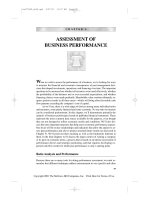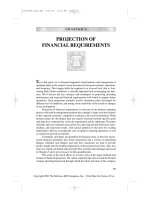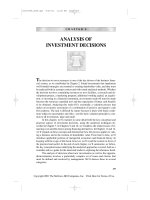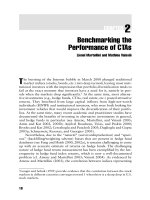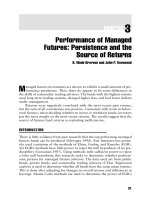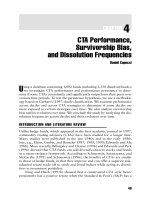Commodity Trading Advisors: Risk, Performance Analysis, and Selection Chapter 18 pps
Bạn đang xem bản rút gọn của tài liệu. Xem và tải ngay bản đầy đủ của tài liệu tại đây (161 KB, 10 trang )
326
CHAPTER
18
Random Walk Behavior
of CTA Returns
Greg N. Gregoriou and Fabrice Rouah
T
his chapter examines whether CTA percent changes in NAVs follow ran-
dom walks with drift. Monthly data from January 1994 to December
2000 are tested for nonstationarity and random walk with drift, using the
Augmented Dickey-Fuller test. All classifications (except the diversified
subindex) are found to behave like random walks, but many of the series
show evidence of a positive drift parameter, an indication that trends could
be present in the series. The effectiveness of CTAs in enhancing risk-return
characteristics of portfolios could be compromised when pure random walk
behavior is identified.
INTRODUCTION
This chapter investigates whether monthly percent changes in net asset val-
ues (NAVs) of commodity trading advisor (CTA) classifications follow ran-
dom walks. Previous econometric studies of financial time series have
employed unit root tests, such as the Augmented Dickey-Fuller test (ADF),
to identify random walk behavior in stock prices and market indices, for
example. The characteristics of CTAs are such that investment into this
alternative investment class can enhance portfolio returns, but these char-
acteristics are likely to be mitigated if pure random walk behavior is pres-
ent because that would imply a lack of evidence of value added to the
portfolio (differential manager skill).
Research into the performance persistence of CTAs is sparse, so there
is little information on the long-term diligence of these managers (Edwards
This article previously appeared in Journal of Alternative Investments, No. 2, 2003.
Reprinted by permission of the publisher.
c18_gregoriou.qxd 7/27/04 11:40 AM Page 326
Random Walk Behavior of CTA Returns 327
and Ma 1988; Irwin, Krukemeyer, and Zulauf 1992; Irwin, Zulauf, and
Ward 1994; Kazemi 1996). However, it is generally agreed that during bear
markets, CTAs provide greater downside protection than hedge funds, and
have higher returns along with an inverse correlation with stock returns in
bear markets (Edwards and Caglayan 2001). The benefits of CTAs are sim-
ilar to those of hedge funds, in that they improve and can offer a superior
risk-adjusted return trade-off to stock and bond indices while acting as
diversifiers in investment portfolios (Schneeweis, Savayana, and McCarthy
1991; Schneeweis 1996).
During the 1990 to 1998 period the correlation of managed futures to
the Standard & Poor’s (S&P) 500 during its best 30 months was 0.33 and
−0.25 during its worst 30 months (Worthington 2001). The benefit of low
correlation cannot be easily replicated through other investment alterna-
tives. According to Schneeweis, Spurgin, and Georgiev (2001), CTAs are
known to short stock markets regularly. One drawback, however, is that
during bull markets their performance is generally inferior to those of hedge
funds (Georgiev 2001).
Investors who choose to include CTAs in their portfolios usually allo-
cate only a small portion of their assets (Georgiev 2001). Others are un-
aware that during increased periods of stock market volatility, careful
inclusion of CTA managers into investment portfolios can enhance their
return characteristics, especially during severe bear markets (Schneeweis
and Georgiev 2002). Moreover, international financial markets in times of
extreme volatility this past decade, such as the Asian currency crisis of 1997
and the Russian ruble crisis of August 1998, did not really affect CTAs. In
fact, CTAs make their money and produce superior returns during such
periods of high volatility. One must consider the possibility that CTA per-
cent changes in NAVs follow random walks, for that would indicate that
temporary shocks in the NAVs are persistent and not reverting to the mean
level. Such behavior would likely affect the timing of CTA allocation in and
out of investment portfolios.
Time series that are “mean reverting” are usually defined as second-
order stationary, weak stationary, or simply stationary in the statistical lit-
erature. These are characterized by a constant mean and variance and by
autocorrelations that depend only on the time lag. Nonstationarity (the vio-
lation at least one of these three conditions) can be ascertained by testing
for the presence of a unit root, using so-called unit root tests such as the
ADF test.
We use the ADF test because of its popularity as a unit root test and due
to its simplicity, since Monte Carlo studies such as Haug (1993a, 1993b)
discovered that it performs well. Some authors have suggested that unit
root tests suffer from low power and that the test does not discriminate very
c18_gregoriou.qxd 7/27/04 11:40 AM Page 327
328 PROGRAM EVALUATION, SELECTION, AND RETURNS
well between mean reverting series and series that do not mean revert at all
(Kennedy 1998). However, the robustness of the ADF test is increased when
lags are used.
If a series is found to be nonstationary by the ADF test, it does not nec-
essarily imply that it behaves like a random walk, because random walks
are but one example of nonstationary time series. Fortunately, the ADF test
also can be used to test specifically for random walks. No CTA strategy that
relies solely on historical prices can be continuously profitable if markets
are efficient and the random walk hypothesis holds true. In this case, future
percent changes in NAVs would be entirely unrelated by the historical per-
formance (Pindyck and Rubinfeld 1998).
Recent studies have shown that a minimal amount of performance per-
sistence is found in CTAs and there could exist some advantages in select-
ing CTAs based on past performance when a long time series of data is
available and accurate methods are used (Brorsen and Townsend 2002).
Schneeweis, Spurgin, and McCarthy (1996) observe that performance per-
sistence is virtually inexistent during the 1987 to 1995 time frame.
The next section of this chapter presents the data along with a brief dis-
cussion of the ADF test and random walks. Following that, we display the
results of the analyses, while the final section summarizes and concludes the
findings.
DATA AND METHODOLOGY
The data set consists of CTA subindices from the Zurich Capital Markets
database/CTA database
1
provided LaPorte Asset Allocation System, cover-
ing monthly percent changes in NAVs from January 1994 to December
2000. The database separates CTAs into these classes: discretionary, trend
follower, currency, diversified, financial, European, systematic, and stock
index (see Table 18.1).
We use the NAVs in each CTA subindex. It is well documented in the
mutual fund literature that daily data provide better estimates than monthly
data, and help increase the power of tests (Busse and Bollen 2001; Kothari
and Warner 2001). Unfortunately, CTA database vendors only provide
monthly data.
1
The Zurich indices during the investigation period do not suffer from survivor-
ship bias.
c18_gregoriou.qxd 7/27/04 11:40 AM Page 328
Random Walk Behavior of CTA Returns 329
The ADF test (Dickey and Fuller 1981; Hamilton 1994) supposes that
the monthly mean CTA return, Y
t
, can be described by equation 18.1:
(18.1)
where ∆Y
t
= Y
t
− Y
t−1
are the first differences
the number of lags, p, chosen is sufficiently large so that the result-
ing error terms e
t
are serially independent.
YY t Y Y
tt t j
j
p
tj t
==++− + +
−−
=
−
∑
11
1
1
αβ ρ λ ε
()
∆
TABLE 18.1 Zurich Advisor Qualified Universe Indices as of December 2000
Trading Style Number Equity Definition of
Subindex of Advisors ($US Billions) Investment Style
Discretionary 54 9.8 Use fundamental/
economic analysis to
make trading decisions
Trend Follower 68 5.5 Focus only on trend-
following strategies
Systematic 200 17.6 Use systematic, but not
purely trend-following
strategies
Market Number Equity Definition of
Subindex of Advisors ($US Billions) Investment Style
Diversified 193 17.8 Limit risk by holding a
large number of positions
Currency 45 5.9 Specialize in currency
trading
European 43 3.6 Specialize in European
commodities markets
Financial 57 9.1 Currency, interest rate,
stock index, and precious
metals
Stock Index 17 0.2 Specialize in stock index
futures and options
Source: T. Schneeweis, R. Spurgin, and G. Georgiev. “Benchmarking Commodity
Trading Advisor Performance with a Passive Futures-Based Index.” CISDM Work-
ing Paper, Isenberg School of Management, University of Massachusetts, Amherst,
MA, 2001, p.14.
c18_gregoriou.qxd 7/27/04 11:40 AM Page 329
330 PROGRAM EVALUATION, SELECTION, AND RETURNS
This condition can be verified by examining the resulting Durbin-Watson
statistic; a value near 2, indicating serial independence. The ADF test works
by running a regression on model 18.1 and calculating a t-statistic (called
the tau-statistic) to test whether the regression parameter r − 1 = 0 (or
equivalently, r = 1). Failure to reject this test indicates the presence of a unit
root and that nonstationarity cannot be rejected. In that case, one often per-
forms the test using first differences: denote these as W
t
= Y
t
= Y
t − 1
, replace
Y
t
by W
t
in equation 18.1, and repeat the analysis.
As explained by Pindyck and Rubinfeld (1998), to test for random
walks, one must suppose that Y
t
in equation 18.1 can be described without
lagged first differences,
Y
t
= Y
t − 1
= a + b
t
+ (r − 1)Y
t − 1
+ e
t
(18.2)
and test whether b = 0 and r = 1 simultaneously. This determines whether
Y
t
instead follows a random walk with drift parameter a, sometimes
referred to as a difference-stationary process (DSP) (Gujarati 1995)
Y
t
= a + Y
t − 1
+ e
t
(18.3)
One then runs the ADF test with p = 1, so that equation 18.1 becomes the
“unrestricted” model
Y
t
− Y
t − 1
= a + b
t
+ (r − 1)Y
t − 1
+ l
1
∆Y
t − 1
+ e
t
(18.4)
while the “restricted” model (b = 0 and r = 1) is
Y
t
− Y
t − 1
= a + l
1
∆Y
t − 1
+ e
t
(18.5)
The error sums of squares from models 18.4 and 18.5 are used to con-
struct an F-statistic for the test of (a, b, r) = (a, 0, 1). Large values of the
F-statistic will lead to the rejection of this hypothesis and to the conclusion
that the model with trend 18.4, rather than the random walk model with
drift 18.5, is the model of choice. Failure to reject this hypothesis provides
evidence toward random walk behavior. Under the null hypothesis (when
the series are nonstationary), neither test statistic just described follows an
F- or a t-distribution, even in large samples, so to assess significance, the
statistics must be compared to critical values tabulated by MacKinnon
(1991), who updated those from Dickey and Fuller (1981).
c18_gregoriou.qxd 7/27/04 11:40 AM Page 330
Random Walk Behavior of CTA Returns 331
EMPIRICAL ANALYSIS
We used up to four lags in the eight CTA subindices but realized that in each
case one lag was sufficient for the e
t
to be serially independent. Table 18.2
contains results of the ADF tests (equation 18.1 with p = 1), on the original
series and on their first differences, along with values of the Durbin-Watson
statistic. We find that none of the CTA subindices is stationary, as evidenced
by the small values of the ADF statistics, ranging from −4.17 to −1.58, none
of which is large enough (in absolute value) to reject the hypothesis of non-
stationarity at the 1, 5, or 10 percent significance level. However, when first
differences are employed, the ADF statistics are all large enough (in
absolute value) to reject nonstationarity at the 1 percent level in all classes.
Durbin-Watson statistics from the original and differenced series are all
near 2, providing evidence of serial independence among the errors and vin-
dicating our choice of p = 1 in equation 18.1.
Thus, it appears that further analyses of these data need only consider
first differences to achieve stationarity and that these analyses would likely
not be exposed to dangers associated with overdifferencing.
Results of the random walk test are found in Table 18.3, which pres-
ents parameter estimates for models 18.4 and 18.5 for the original series Y
t
,
along with corresponding standard errors in parentheses. The F-statistic for
testing (a, b, r) = (a, 0, 1) is presented in the last column. We find evidence
TABLE 18.2 ADF Test Statistics of Nonstationarity and Durbin-Watson Statistics
of Serial Correlation (Equation 18.1 with p = 1), for Monthly CTA Mean Returns,
(1994 to 2000)
ADF Statistic (DW Statistic)
CTA Trading Advisor Original First
Subindexes Series Y
t
Differenced Series W
t
Discretionary Advisor –3.48 (1.98) –6.44* (2.00)
Trend Follower –2.76 (1.95) –6.08* (1.94)
Financial Program –2.62 (1.96) –5.74* (1.94)
Diversified Advisor –4.17 (1.94) –6.82* (1.91)
Currency Program –2.73 (1.96) –7.79* (1.96)
European Advisor –2.74 (1.87) –6.48* (1.78)
Systematic –2.69 (1.92) –6.40* (1.90)
Stock Index –1.58 (2.03) –5.95* (2.07)
*Significance of ADF statistic at the 1 percent level, from MacKinnon (1991).
c18_gregoriou.qxd 7/27/04 11:40 AM Page 331
TABLE 18.3 Parameter Estimates from Dickey-Fuller Unit Root Tests of Monthly CTA Class Mean Returns, (1994 to 2000),
on Original Series
Zurich CTA Trading Advisor F-statistic for test of
Subindex ABR− 1 L
1
(A, B, R) = (A, 0, 1)
Discretionary Equation (18.4) 147.790 −0.2319 0.1895 1.6662
(41.350) (0.0660) (0.1060) (0.4690) 6.34
Equation (18.5) 6.100 — — 0.1120
(1.757) — — (0.1100)
Trend Follower Equation (18.4) 91.602 −0.1690 0.1420 0.8580
(31.958) (0.0610) (0.1160) (0.3350) 3.82
Equation (18.5) 5.033 — — 0.0530
(3.147) — — (0.1150)
Financial Equation (18.4) 50.749 −0.1420 0.2120 0.5890
(18.449) (0.0540) (0.1170) (0.2410) 3.43
Equation (18.5) 3.430 — — 0.1270
(1.979) — — (0.1160)
Diversified Equation (18.4) 86.360 −0.3620 0.2070 0.9040
(20.243) (0.0870) (0.1150) (0.2200) 8.69*
Equation (18.5) 2.758 — — 0.0220
(1.205) — — (0.1160)
332
c18_gregoriou.qxd 7/27/04 11:40 AM Page 332
TABLE 18.3 (continued)
Zurich CTA Trading Advisor F-statistic for test of
Subindex ABR-1 L
1
(A, B, R) = (A, 0, 1)
Currency Equation (18.4) 31.6000 −0.161 0.088 0.247
(11.2540) (0.059) (0.111) (0.091) 3.76
Equation (18.5) 1.2250 — — 0.018
(0.5520) — — (0.112)
European Equation (18.4) 17.9540 −0.164 0.066 0.087
(6.4550) (0.060) (0.121) (0.031) 3.90
Equation (18.5) 0.4730 — — −0.020
(0.1777) — — (0.121)
Systematic Equation (18.4) 19.2490 −0.166 0.122 0.162
(6.8070) (0.062) (0.120) (0.064) 3.64
Equation (18.5) 0.9520 — — 0.025
(0.4780) — — (0.118)
Stock Index Equation (18.4) 6.5060 −0.065 −0.005 0.004
(4.1210) (0.041) (0.011) (0.015) 1.26
Equation (18.5) 0.0890 — — −0.036
(0.3480) — — (0.110)
*Significant at the 5 percent level.
Values in parentheses are standard errors of parameter estimates. Critical values for the F-test with n = 75 are 6.61 at the 5 percent
level and 9.02 at the 1 percent level, from Dickey and Fuller (1981), Table VI.
333
c18_gregoriou.qxd 7/27/04 11:40 AM Page 333
of random walk behavior in all CTA subindices except for diversified, whose
F-statistic of 8.69 attains significance at the 5 percent level. It is therefore
possible that a trend representation exists for this series. None of the
F-statistics for the other series are large enough to attain significance. Thus,
all classes are better represented by equation 18.5 except diversified, for
which equation 18.4 is the model of choice.
Large estimated values of the drift parameter coupled with small stan-
dard errors (usually defined as less than one-half of the drift parameter in
absolute value) would suggest that a drift could be present in the series.
Table 18.3 thus provides evidence of positive drift (a > 0) in the discre-
tionary, diversified, currency, and European classes. Only the stock index
class appears to behave as a pure random walk.
CONCLUSION
The nonstationarity observed in most CTA subindices implies that port-
folio managers wishing to include CTAs within a traditional stock and
bond portfolio cannot be assured that their NAVs will be mean reverting.
Yet evidence of positive drift in some of the CTA subindices under consid-
eration leaves open the possibility that these NAVs will contain increasing
trends. Portfolio managers wishing to obtain reliable predictions of CTA
percent changes in NAVs therefore must be careful when using historical
data to design future trading strategies. CTAs assume both long and short
market positions, and realize profits when there are persistent trends in
markets and when those trends can be identified early enough. Thus, the
performance of CTAs depends not only on price movements, but also on
the managers’ ability to identify them.
One possible explanation for random walk behavior during the exami-
nation period is due to the fact that traditional CTAs make large profits
during extreme market movements, themselves random events. Their corre-
lations may be more accurate and stable if they are used as a hedge against
short volatility exposure. The discretionary, currency, and European traders
trade in periods of high liquidity, which has been the case since 1995. We
found that only one class, diversified, did not behave as a random walk,
likely since trends in a diversified portfolio are stable, although they may not
produce sufficient profits to satisfy the expectations of all investors. Due to
their very low or negative correlation to stock markets, CTAs are usually less
affected by severe market shocks, such as those caused by the Asian crisis of
1997 and the collapse of the Russian currency in August 1998. By allocat-
ing assets into CTAs whose returns are not pure random walks, portfolio
managers can, in times of increased volatility, add value to traditional stock,
334 PROGRAM EVALUATION, SELECTION, AND RETURNS
c18_gregoriou.qxd 7/27/04 11:40 AM Page 334
bond, and currency portfolios by providing returns that are more readily
predictable. Inclusion of CTAs therefore will provide portfolios with immu-
nization against extreme stock market movements.
This study has attempted to characterize some of the time series prop-
erties of CTA classes. Using subindices does not provide information on any
particular CTA, only on the overall behavior of CTAs within each classi-
fication. Thus, our results are especially useful for investors wishing to allo-
cate holdings into all CTAs within a particular class—in that case the
subindex would represent an adequate measure of monthly performance.
However, investors wishing to invest in a small number of CTAs would
likely benefit from an analysis similar to this one but that targets individ-
ual CTAs. Further investigation into the returns of CTAs is warranted, as
increased volatility in stock markets is likely to spur additional interest
in these alternative investments on the part of investors, academics, and
practitioners.
Random Walk Behavior of CTA Returns 335
c18_gregoriou.qxd 7/27/04 11:40 AM Page 335

